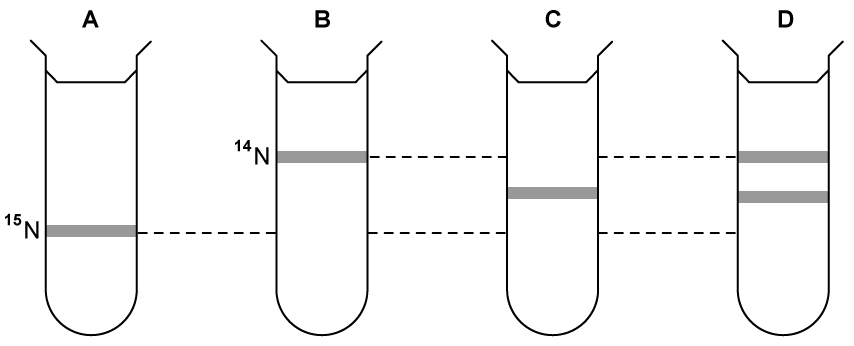Which of the following would be the result of analysing a DNA molecule 14 000 base pairs in length?
28 000 pentose sugars, 14 000 phosphate groups, an equal ratio of cytosine to thymine bases and an equal ratio of guanine to adenine bases
28 000 pentose sugars, 28 000 phosphate groups, an equal ratio of cytosine to guanine bases and an equal ratio of thymine to adenine bases
14 000 pentose sugars, 28 000 phosphate groups, an equal ratio of cytosine to thymine bases and an equal ratio of guanine to adenine bases
28 000 pentose sugars, 28 000 phosphate groups, an equal ratio of cytosine to thymine bases and an equal ratio of guanine to adenine bases
Choose your answer A B C D
View Answer
Next Question
Which of the following would not be considered an advantage of complementary base pairing in DNA?
It enables each DNA strand to act as a template for the formation of a new strand during replication
Hydrogen bonding between complementary bases stabilises the structure of the DNA molecule
It ensures genetic continuity between generations of cells so that they all contain the same genetic information as the parent cells
It plays an important role in maintaining the covalent bonds within the DNA molecule
Choose your answer A B C D
View Answer
Previous Question Next Question
Which of the rows in the following table correctly identifies the function of each enzyme listed?
Helicase RNA polymerase DNA polymerase
A. Breaks the hydrogen bonds between complementary DNA bases
Links thymine to the adjacent nucleotide through covalent bonds
Binds to a template DNA strand and pairs uracil up with adenine
B. Responsible for the formation of hydrogen bonds between complementary DNA bases
Binds to a template DNA strand and pairs uracil up with adenine
Links thymine to the adjacent nucleotide through covalent bonds
C. Breaks the hydrogen bonds between complementary DNA bases
Binds to a template DNA strand and pairs uracil up with adenine
Links thymine to the adjacent nucleotide through covalent bonds
D. Binds to a template DNA strand and pairs uracil up with adenine
Links thymine to the adjacent nucleotide through covalent bonds
Responsible for the formation of hydrogen bonds between complementary DNA bases
Choose your answer A B C D
View Answer
Previous Question Next Question
The following events occur in the process of DNA replication.
Complementary strands are separated
Free DNA nucleotides pair with complementary nucleotides on each template strand
Hydrogen bonds are formed between complementary bases
Hydrogen bonds are broken between complementary bases
Covalent bonds form between the pentose sugar and the phosphate group of adjacent nucleotides
Which of the following is the correct order of the events?
Choose your answer A B C D
View Answer
Previous Question Next Question
The experiments done by Meselson and Stahl in the 1950s provided evidence that DNA replication was semi-conservative.
They transferred bacteria that contained only 15 N in their DNA and transferred them to a medium containing only 14 N. They allowed the bacteria to divide twice and then centrifuged the DNA.
The following diagram shows a few test tubes with results from their investigation.
Which of these test tubes shows the predicted results after two generations in the medium with the light isotope?
Choose your answer A B C D
View Answer
Previous Question
